
Rediscovering Japan

Rediscovering Japan
Travel (Wakayama/Mie Part 1 (Ise))

by tomizuta
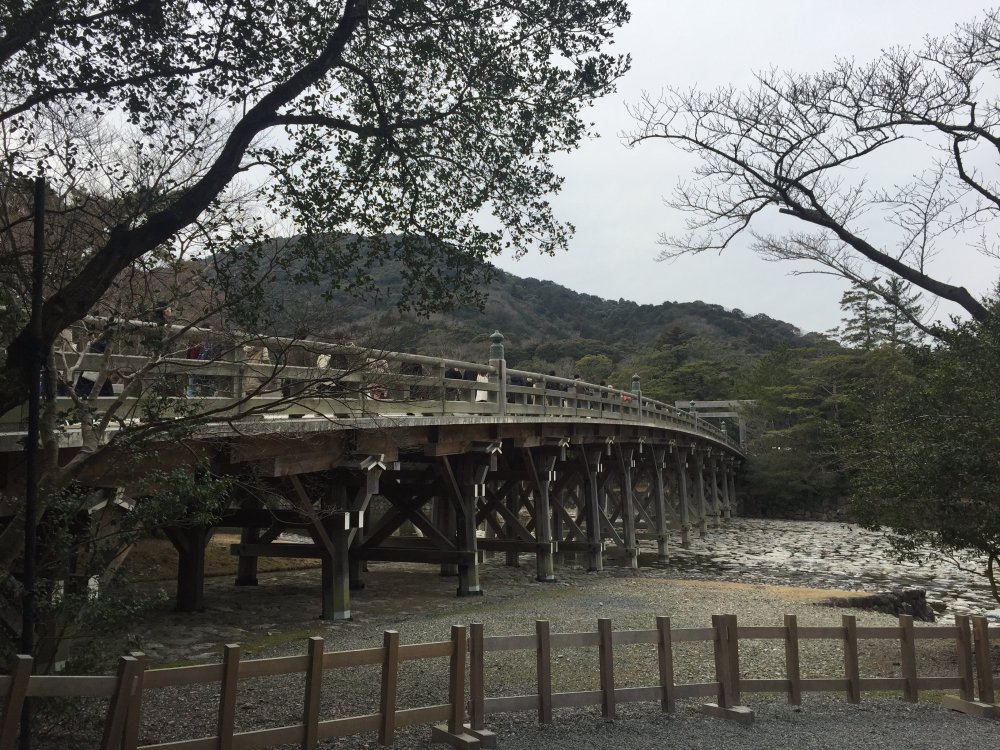
Ujibashi is the bridge that crosses Isuzu River and is the entrance route from the township in the far opposite.
In the Edo era, travel was very much restricted and there were many inspection points to cross the borders between fiefdoms. In order to travel, one needed a passport issued by a fiefdom (in case of a samurai) or the Buddhist temple to which the person belonged. The purpose of the travel was strictly scrutinized, but if the purpose was pilgrimage to Ise-jinguu, Zenkouji Temple or Toushouguu, it was easier to have a passport granted. I will talk about Zenkouji Temple and Toushouguu separately, but Ise-jinguu has traditionally been recognized as the highest ranking Shinto shrine, as it worships the Great Goddess Amaterasu who was entrusted the rule of Japan as well as being a five generation ancestor of the first Emperor Jinmu. We had never been to Ise-jinguu, so it was a must for me to visit in my quest to rediscover Japan. In March 2017, we booked ourselves on a three day guided tour to Ise-jinguu and Kumano-kodou (Sacred Sites and Pilgrimage Routes in the Kii Mountains, a World Heritage site) spreading to the west and south of Ise-jinguu.
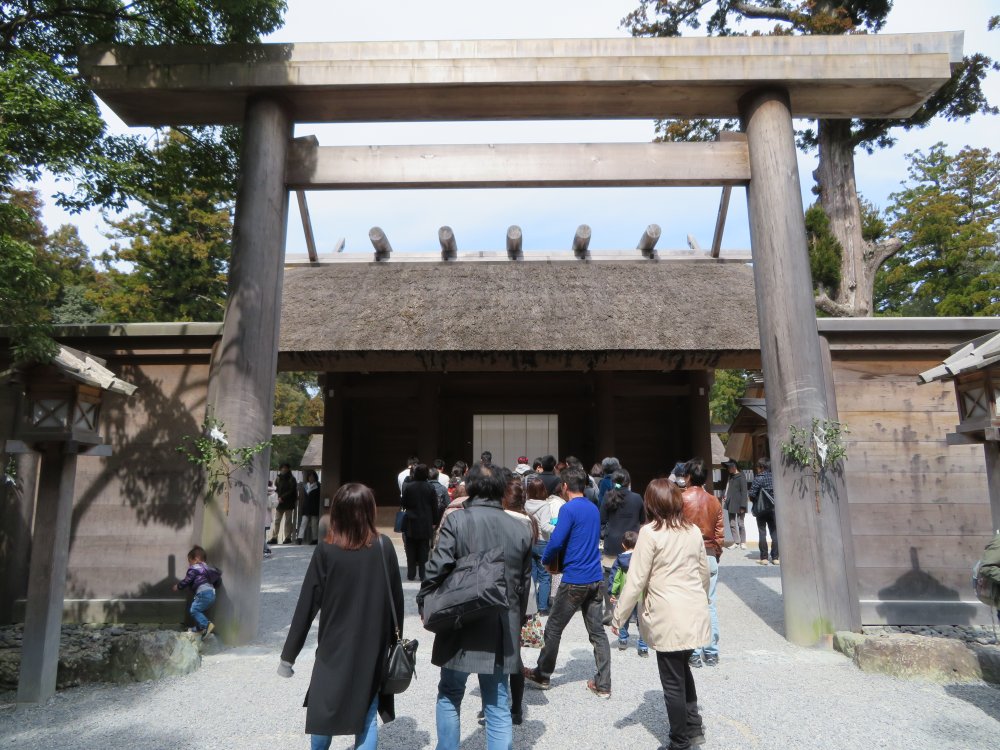
Visitors queue and wait for their turn to get to the front of the altar of the Shouguu (main shrine) of Geguu.
Ise-jinguu is composed of 125 Shinto shrines, of which two are the main
shrines, Geguu (outer shrine) and Naiguu (inner shrine). The Goddess Amaterasu
is worshipped at Naiguu and the Goddess Toyouke at Geguu. Goddess Amaterasu
is the most revered deity in Shinto and the Imperial Family proclaims to
be her descendants. According to Japan’s oldest chronicle Nihon-shoki compiled
in the early 8th century, Amaterasu used to be worshipped by the Emperor
in the Imperial Court. But in the reign of the 10th Emperor Sujin, there
was a plague that he thought was because he was both worshipping and reigning
and not fully dedicated to worship and moved the sacred mirror of Yata
(one of the three sacred objects entrusted to the Imperial Family to authorize
their reign) out of the Court. The 11th Emperor Sujin ordered his princess
to find a suitable place to enshrine Goddess Amaterasu. The princess finally
found Ise by the banks of the Isuzu River to be the proper place to worship
Amaterasu. Later, Amaterasu appeared in the 21st Emperor Yuuryaku’s dream
and instructed him to bring Toyouke from Tamba (now northern Hyogo prefecture)
to prepare her food. Toyouke is the Goddess of farming and industry.
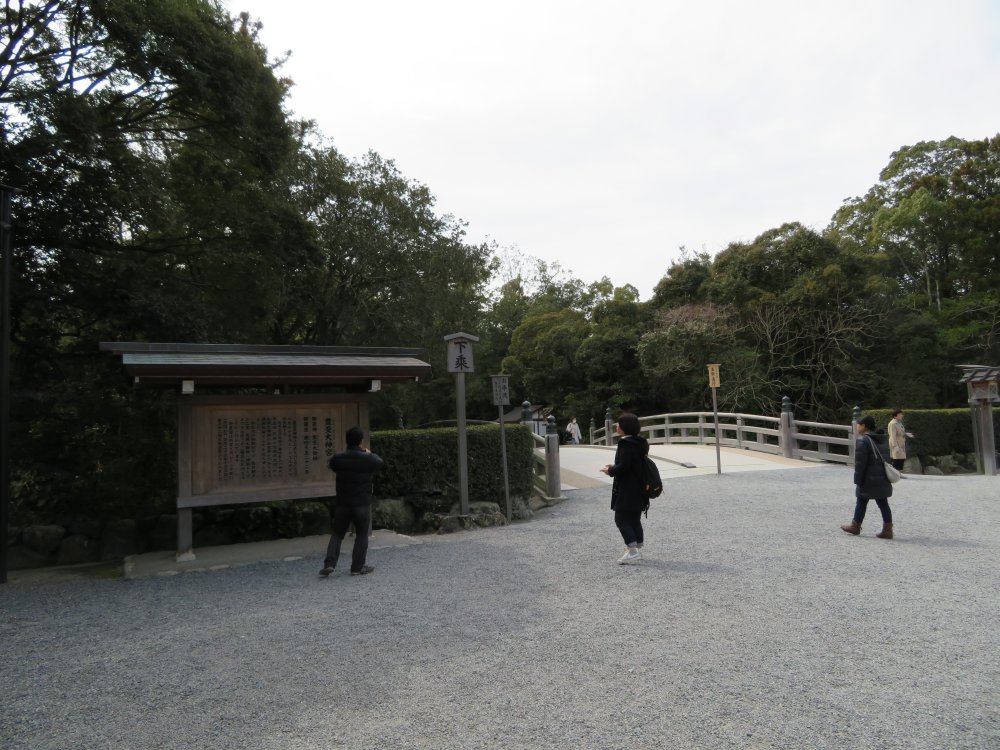
Hiyokebashi (fire prevention bridge) is the entrance to the Geguu grounds. The path in the middle was for the Gods to pass.
Our tour first took us to Geguu, which I understand is the proper route to visit Ise-jinguu. We had to first cross a wooden bridge called Hiyokebashi (Fire Prevention Bridge). Visitors to the Geguu were to walk on the left and those leaving on the right. The path in the middle was for the Gods to pass. We were told that we had to start from the left foot when crossing the bridge so as not to show our back to the Gods. We were taken to the Goshouguu (main shrine) where Goddess Toyouke resides. Our guide advised us to just declare who we were and where we came from when we came in front of the altar and make our wishes at another shrine, Takanomiya within the Geguu. There is no disagreement about the latter but for the former the prevalent belief seems to be that we should be making wishes for the world or a greater good than our personal meager wishes. I remembered that in the old days, visiting Ise was a once in a lifetime event. Villagers would save to fund the trip for a group of people to pay respects and pray on their behalf. The representatives must have had a huge obligation to let the Gods know exactly who were paying their respects and to relay of their individual wishes correctly. Whatever the prevalent understanding is, I thought it made a lot of sense to first declare who had come and then relay all the individual prayers which must have taken a long time.
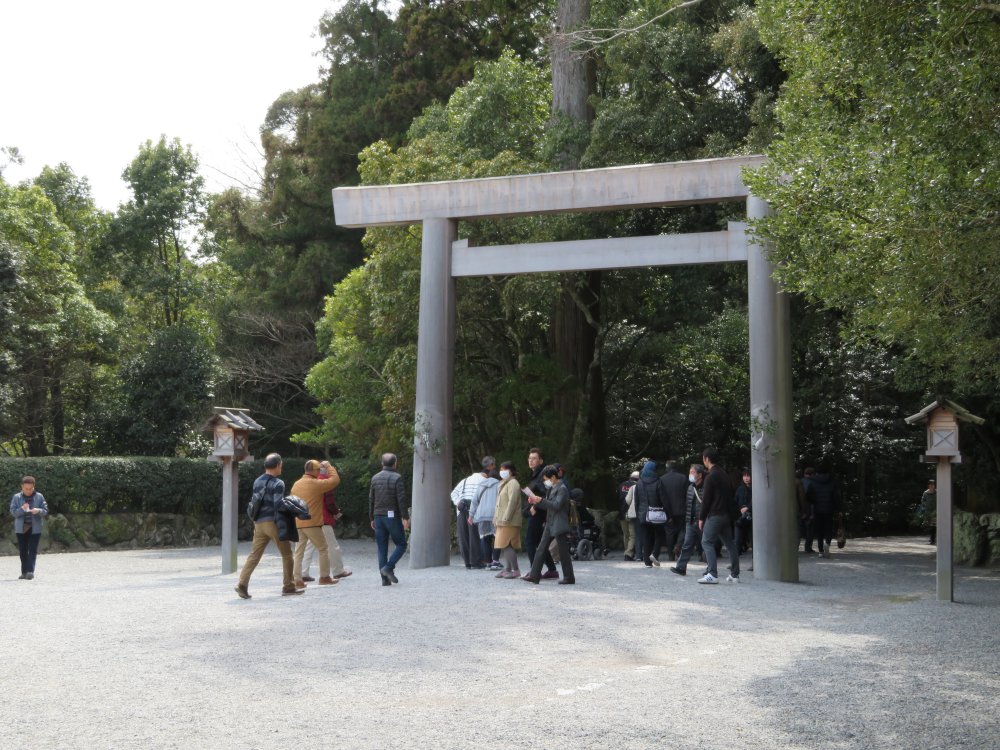
The modest wooden entrance gate to Geguu. Note that there is no shimenawa but branches with white tape instead.
There was a large open space next to the Goshouguu. We were told that that plot was where the previous Goshouguu stood and the next Goshouguu would be constructed. Every twenty years, the Goshouguu and other shrines would be reconstructed for the Gods to relocate. This is called Shikinen-senguu. The last was in 2013 and the next would be 2033. I understand this is the main reason that Ise Jinguu has not been nominated as a candidate for World Heritage designation as it is contradictory to the theme of preservation.
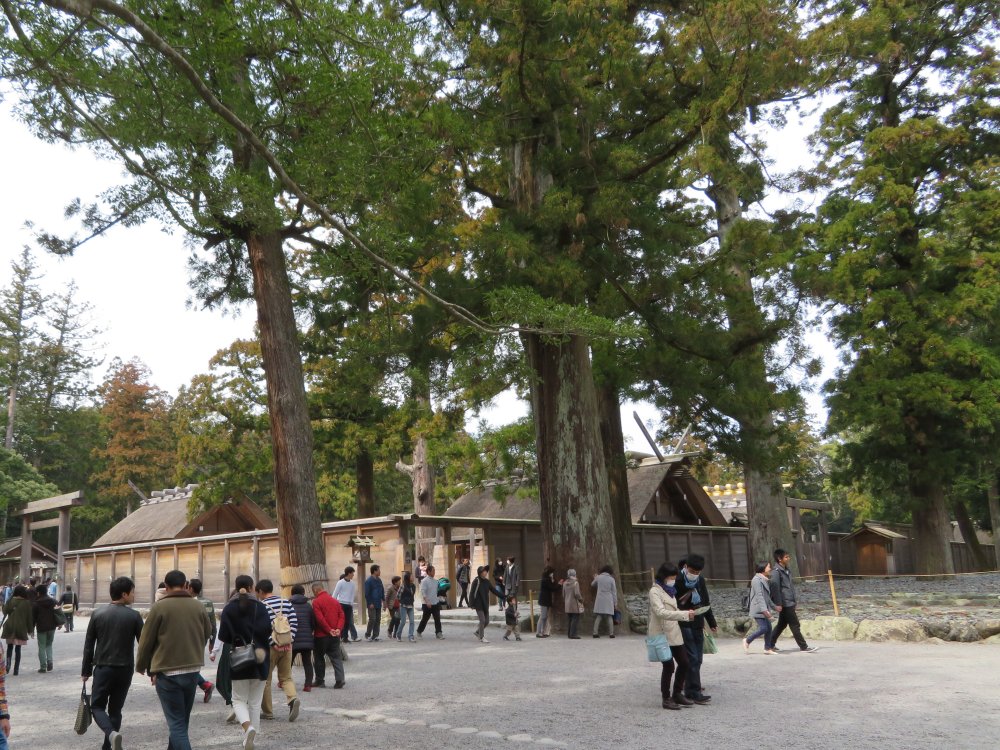
The plot on the right is where the former Shouguu stood.
Takanomiya was about five minutes’ walk away and thirty steps up from Goshouguu. There was a long queue of people waiting to make their wishes in front of the altar. Takanomiya appeared simple in structure and had a fresher look than I had expected.
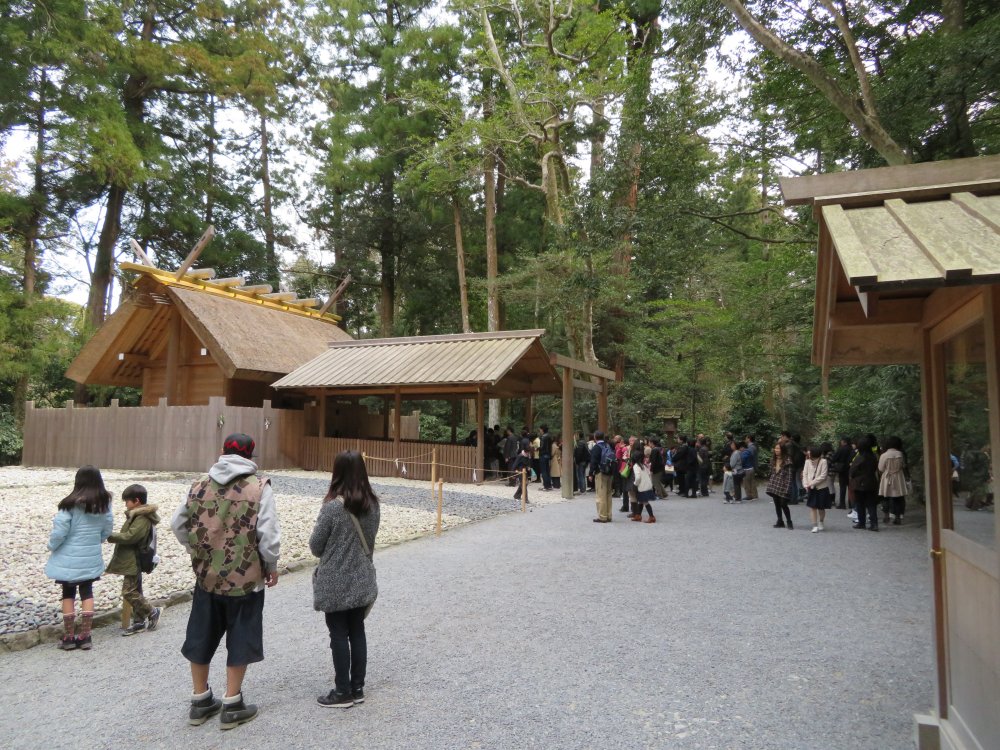
There was a long queue of people waiting to make their wishes in front of the altar.
I noticed some banners proclaiming a Sumo tournament. Sumo is the national sports of Japan although nowadays we have many non-Japanese Sumo wrestlers. Professional Sumo tournaments are held on odd months for fifteen days, and the tournaments are held in Tokyo (January, May and September), Osaka (March) Nagoya (July) and Fukuoka (November). In between these main tournaments, Sumo wrestlers hold special one day tournaments or events in the countryside. Between the March and May tournaments a one day tournament is held every year in Ise. The tournament starts at 7am in the morning at an arena in Ise and from 11:00am the Yokozuna champions and ranked wrestlers move to the Naiguu to hold a ritual including Dohyouiri of the Yokozunas as offering to the Gods.
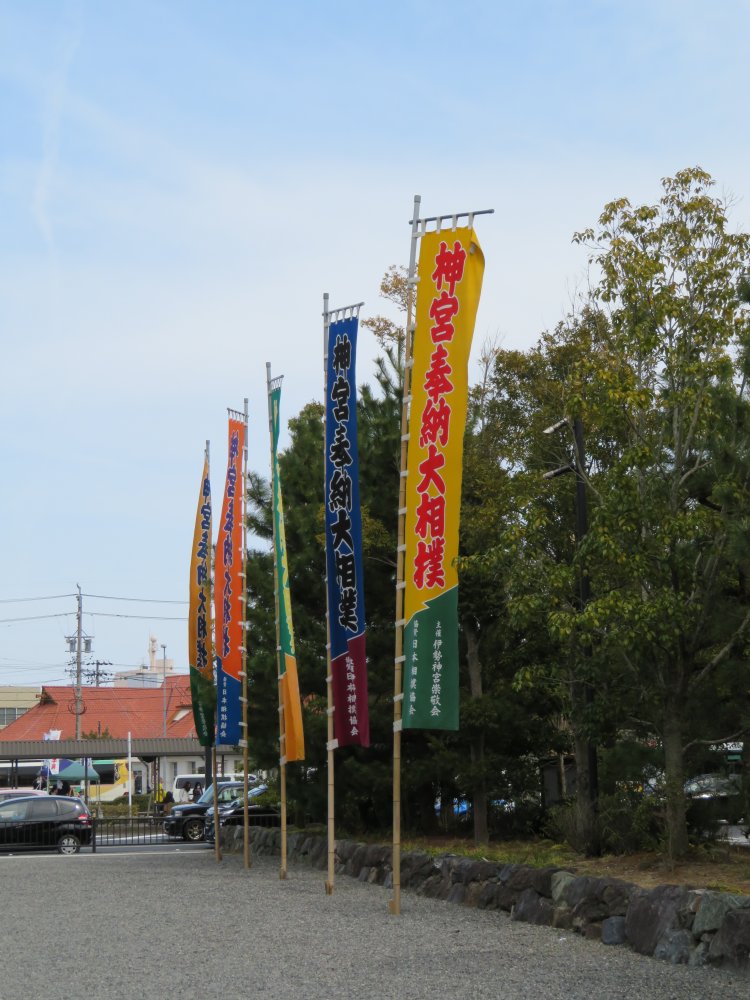
Banners proclaiming a Sumo tournament close to Hiyokebashi
The entrance to the Naiguu is a bridge called Ujibashi that crosses over
Isuzu River. There is a good photo spot on your left once you cross the
bridge. We turned to the right through the main path leading to the Shouguu
(main shrine). On our way we went down a slope to the banks of Isuzu River
where visitors purify themselves with the river water.

Visitors purify themselves with the river water.
Adjacent to the purifying area is a shrine called Takimatsurinokami dedicated to the Water God of Isuzu River. It is tucked away in the woods and often unnoticed but is an important place to pay your respect as it is believed that the God will then relay your message to Goddess Amaterasu. With so many pilgrims having such an intermediary must be very helpful to Goddess Amaterasu. Our guide led us past the grand Kagura Theater to the Shouguu at the very end.
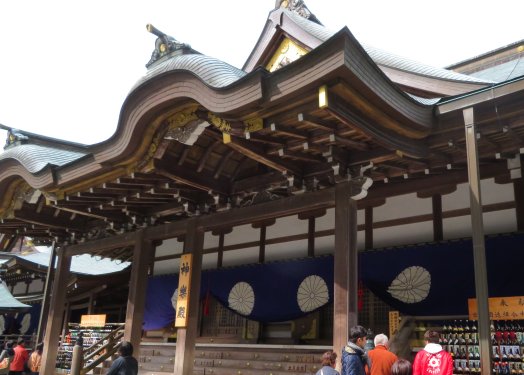
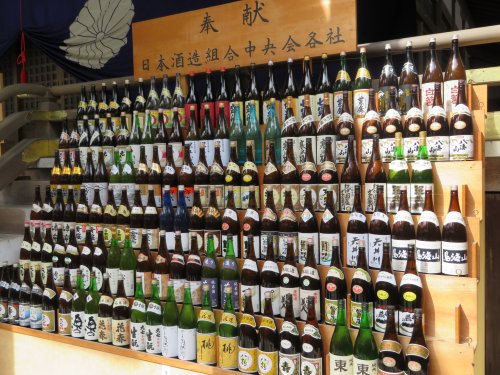
It must be because of its prominence that sake from all parts of Japan was offered to the Gods at the Kagura Theater.
Our guide again advised us to declare who we were in front of the altar and save our personal prayers till we visited Aramatsurinomiya, same practice as in the Geguu.
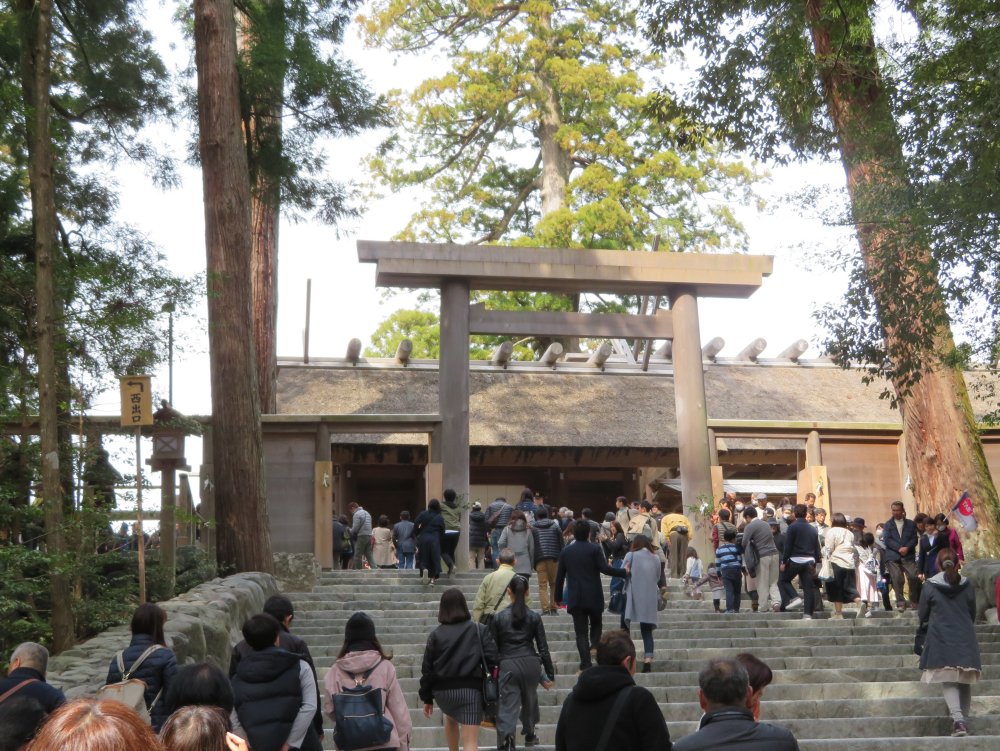
Visitors going up to the altar of the Shouguu
Compared with the Shouguu the queue in front of Aramatsurinomiya was relatively
short.
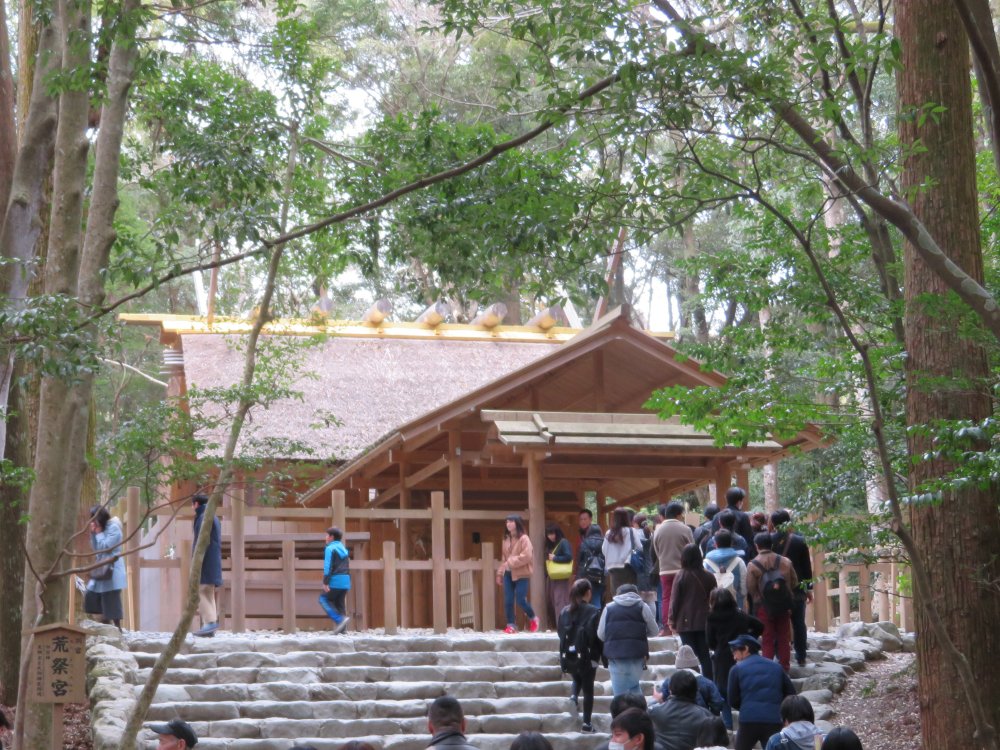
The queue in front of Aramatsurinomiya was relatively short.
In the Edo era, more than two million people visited Ise-jinguu, and the
Monzenmachi (township in front of the shrine gates) of Oharai-machi prospered
as the pilgrims traveled through the town to reach the Naiguu. But by the
end of the 1970s the number of visitors to Oharai-machi had dwindled to
only two hundred thousand while annual visitors to Ise-jinguu had increased
to five million. This was because the visitors were bypassing the town
traveling to Ise-jinguu by cars and buses via a national road running parallel
to the route through the town. The sweets manufacturer Akafuku led efforts
to restore and preserve the traditional Japanese architecture in the area.
Okage–yokochou was opened In 1993, the year of a Senguu. This is a shopping
area composed of 28 buildings newly built or relocated from elsewhere in
a genuinely old Ise style from the late Edo to early Meiji era. According
to statistics released by Ise City 5 years ago, the number of visitors
to Okage-yokochou is getting close to five million annually. Facing the
entrance gate to the Naiguu of Ise-jinguu, the shopping area of Oharai
High Street is located on the left and runs about 800 meters. The street
is packed with numerous gift shops, sweets shops and eateries, many of
which preserves Ise style buildings from the Edo era. It being a Saturday,
the street was packed with visitors. Akafuku’s main building is on the
right hand side a little further than the middle point of the street. Akafuku
is a very popular sweets which is a rice cake coated with red bean paste.
There was a long queue of shoppers wishing to purchase Akafuku made on
the spot.
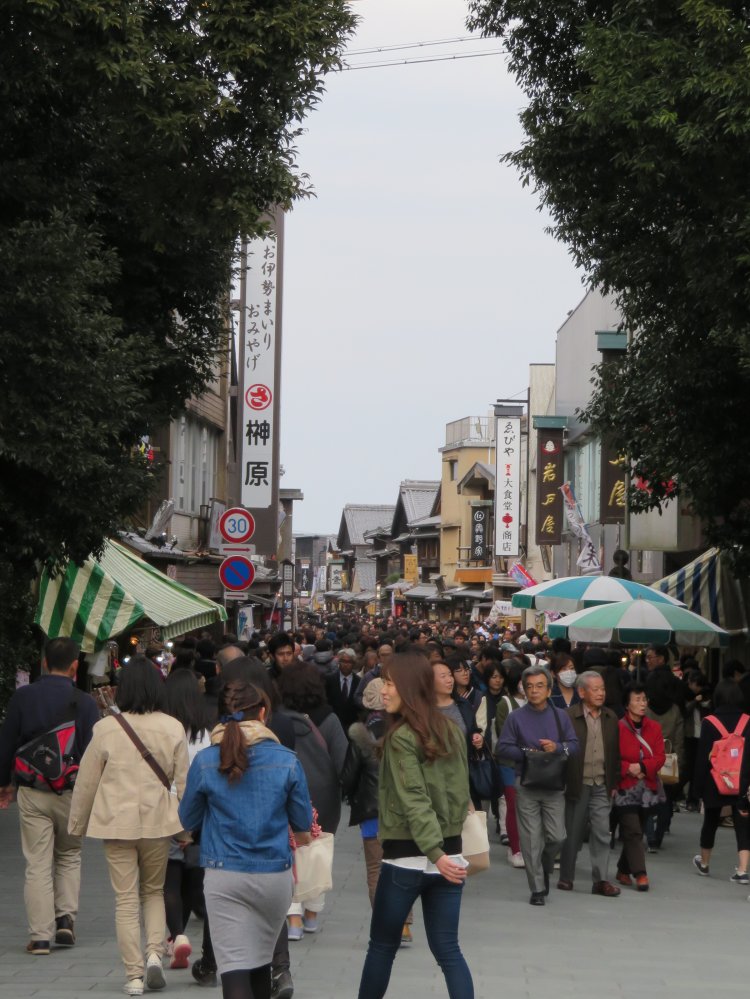
The Oharai High Street was packed with tourists.
If you turn left when you arrive at Akafuku, that is Okage-yokochou that
I explained before. We entered a theater museum of Japanese mythology where
the attraction is a film as well as a guided tour of the museum displays.
We found this very informative on this visit to Ise and Kumano which is
all related to mythology. Unfortunately I don't think they have an English
version. Although I understand that Okage-yokochou has been a huge success,
I thought that the high street itself had so much to offer.
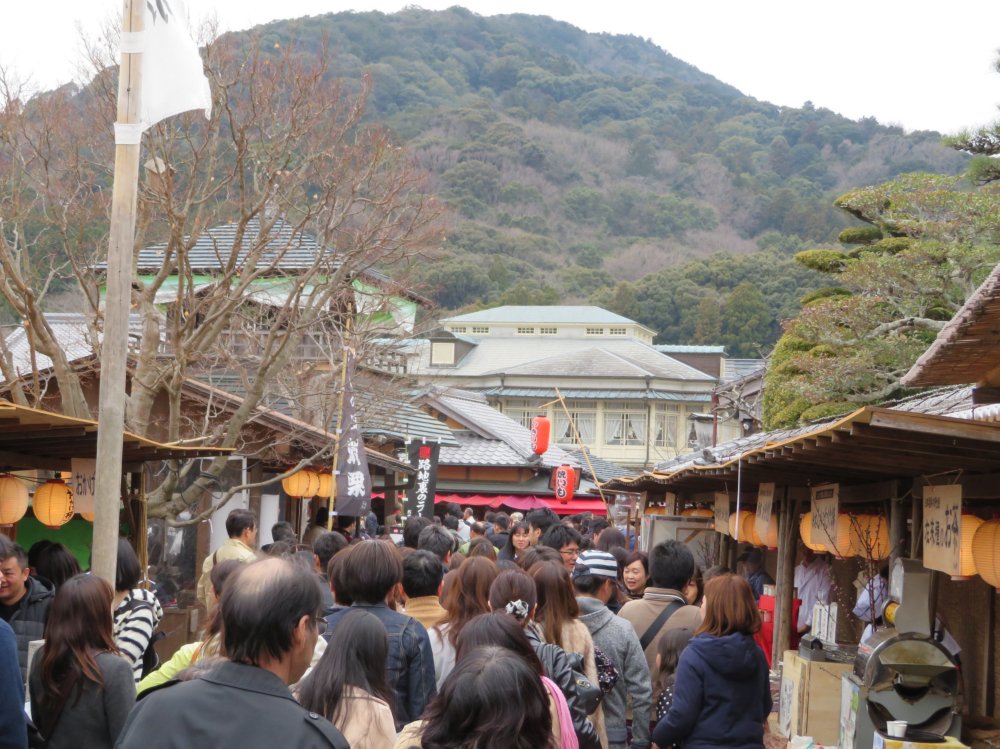
The Okage-yokochou has been a huge success.
There are many shops selling sake and a lot of them will offer sake in
small quantities (90 mililiters or 180 mililiters) for 300 to 600 yen.
I entered a brewery shop Iseman. They had two brands, Oimidori (old green)
and Okagesama (thanks to you). I asked which was drier and was recommended
Oimidori. I tried 90 milliliters and found it most palatable. I also liked
the old style label. The shop lady told me this was a sake brand that started
in the early 18th century.
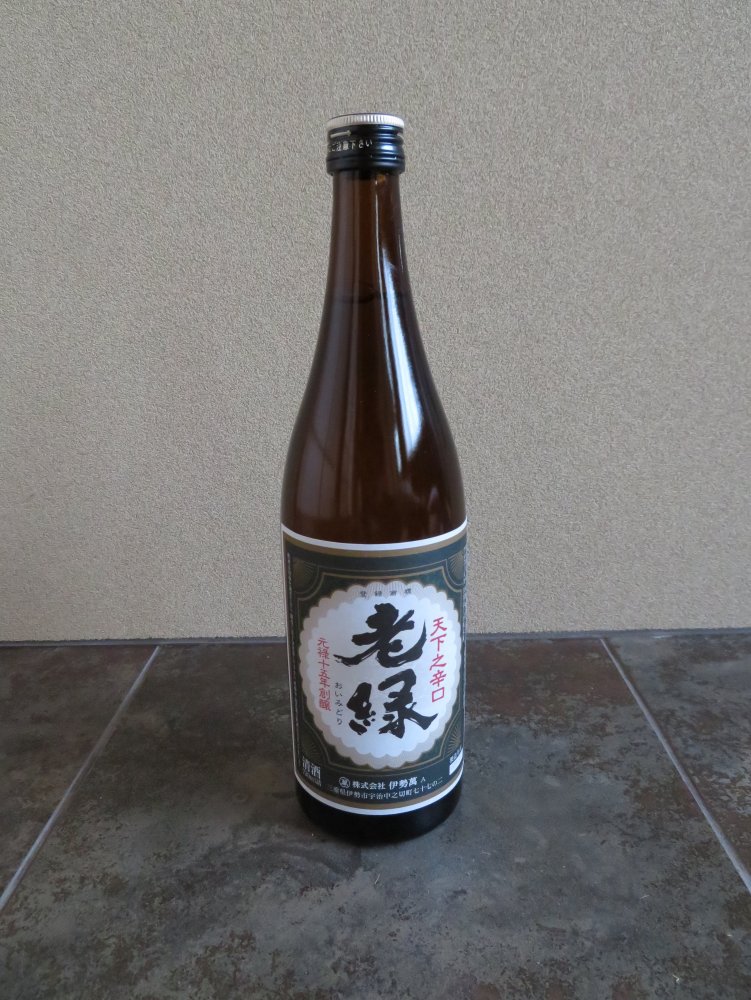
A 720 milliliters bottle of Oimidori. It says brewed since 1703.
We also managed to purchase a pack of Akafuku during our tour. Note the
wavy feature of Akafuku. Our guide told us that this is to depict the pebbles
and the water of the Isuzu River.
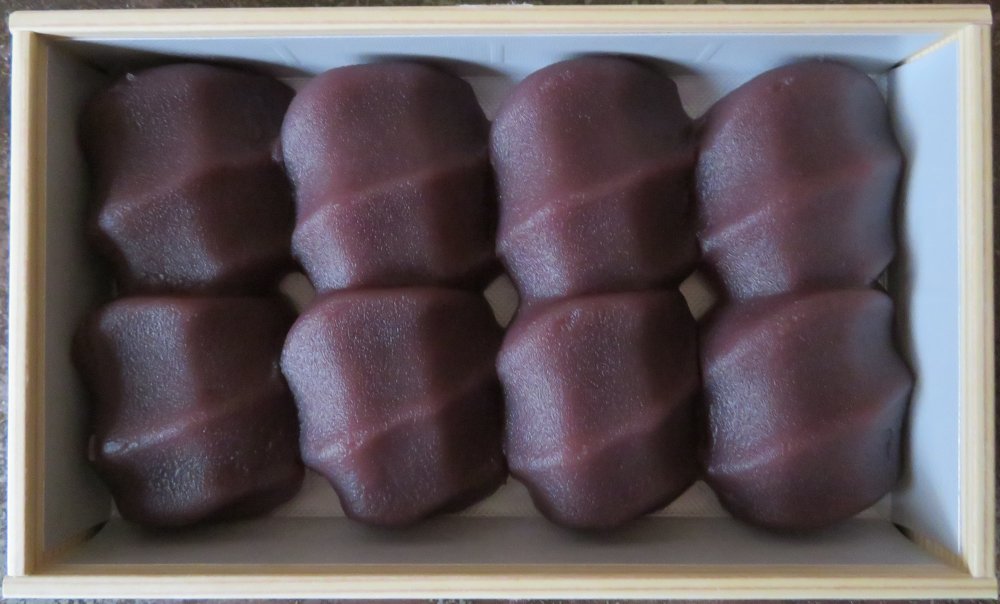
Note the wavy surface of Akafuku.